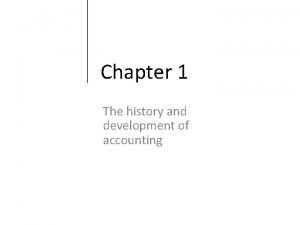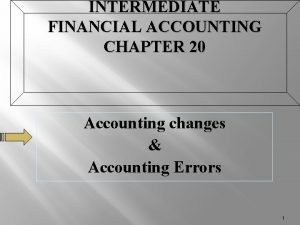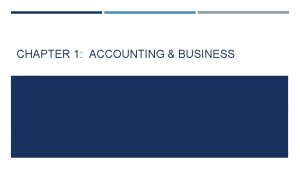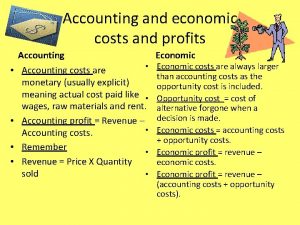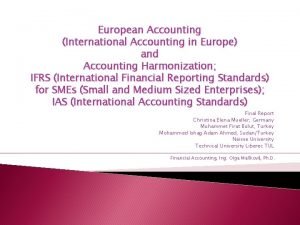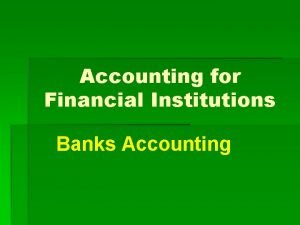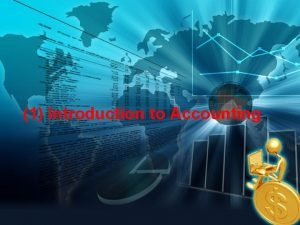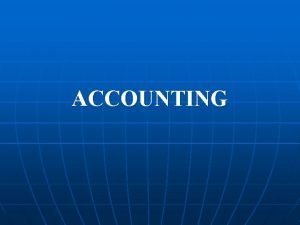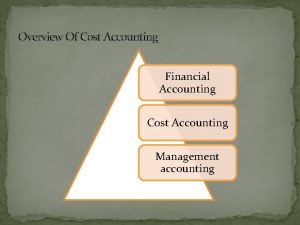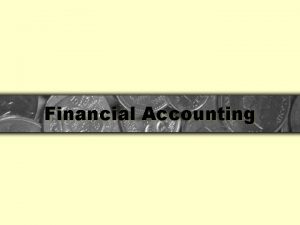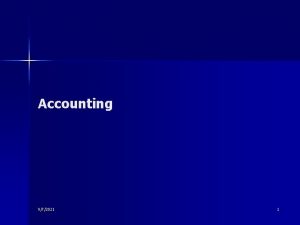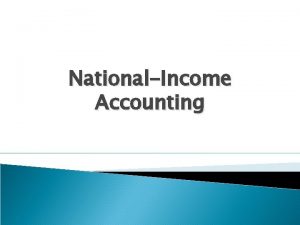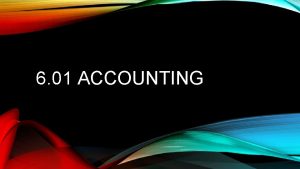Chapter 1 The history and development of accounting



































- Slides: 35

Chapter 1 The history and development of accounting

1. 1 Introduction v. Why history of the development of Accounting is important? v. History of the development of Accounting is important to an: 1 - understanding and 2 - appreciation of present and future practices, as well as of the institutional structure of the discipline. 2

1. 2 Evolution of Double Entry Book-keeping. 1. 2. 1 Early history of accounting § There is evidence of double entry accounting in many early civilisations: - Chaldean–Babylonian - Assyrian - Sumerian - Egyptian - Chinese - Greek - Roman 3

1. 2. 1 Early History of Book-Keeping: Attempts have been made to locate time and place of birth of the double entry system. v Following Civilizations dating back to 3000 BC recognizes some form of record-keeping. v. Chaldean-Babylonion, Assyrian and Sumerion civilization– Producer of the first organized government of the world, oldest written languages and oldest surviving business records. v 4

v. Egyptian Civilization: where scribes formed the pivots on which the whole machinery of the treasury and other departments turned. (Scribes: Not everyone was allowed to learn ( read and write) in ancient Egypt. Only one group of people called scribes was allowed to have this knowledge. Pivot, the point of rotation in a lever system; More generally, the center point of any rotational system)

v. The Chinese Civilization: Govt. Acc playing a key and Sophisticated role during the Zhou Dynasty (empire) (1122 -249 BC). v. Greek Civilization: Where Zenon introduced an elaborate system of responsibility accounting in 256 BC. v. Roman Civilization: laws requiring taxpayers to prepare statements of their financial positions and with civil rights depending on the level of property declared by citizens. 6

The presence of these forms of book-keeping in ancient world has been attributed to various factors. e. g, v the invention of writing, v introduction of Arabic numerals and decimal system, vthe knowledge of Algebra, vthe presence of inexpensive writing materials , v the rise of literacy, v the existence of standard medium of exchange. 7

A C. Littleton’s lists seven preconditions for the emergence of systematic bookkeeping are: - The art of writing(Since Book-keeping is first of all a record) - Arithmetic (Since the mechanical aspect of book- keeping consists of a sequence of simple computations) - Private property (Since book-keeping is concerned only with recording the facts about property and property rights ) 8

A C. Littleton’s lists seven preconditions. . Continued - Money(i. e. among economy. Since book-keeping reduces all transactions in property or property rights to this common denominator ) - Credit (i. e. incomplete transactions. Since there would be little impulse to make any record whatever if all exchanges were completed on spot in cash) - Commerce ( Since merely local trade would never have been created enough pressure to stimulate men to coordinate diverse idea into a system) - Capital (Since without capital commerce would be trivial and credit would be inconceivable) 9

Italian Book-keeping • Italian book-keeping prospered(How ? ) with the development of the commercial republics of Italy and the use of the double-entry method in the 14 th century. • The first double entry books known to exist are those of Massari of Genoa, dating from the year 1340. This preceded Pacioli by some 200 years. 10

Italian Book-keeping. . Continued • Early Development of Accounting in Italy: Rymond de Rover described it as: • the achievement of the Italian merchants roughly between 1250 and 1400, was to fuse all these heterogeneous elements into an integrated system of classification in which the pigeonholes were called accounts and which rested on the principles of dual entries for all transactions , however balancing the books was not a primary objective of medieval accounting.

Italian Book-keeping. . Continued v On the contrary in Italy the merchants begun by 1400 to use accounting as a tool of management control. v They developed the rudiments (basics) of cost accounting, v introduced reserves and other modes of adjustments, such as accruals and deferred items. v They also gave attention to the audit and balance sheets. v These merchants however made little progress in the analysis of financial statements. v A rudimentary (basic) form of double accounting existed 12 among the ancient Incas in 1577.

1. 2. 2 Luca Pacioli’s Contribution • Luca Pacioli, a Franciscan friar is generally associated with the introduction of doubleentry book-keeping. • In 1494 he published his book , Summa de Arithmetica, Geometrica, Proportioni et Proportionalita which includes two chapters –De Computis Scripturis , describing double-entry book-keeping. • He did not invent double entry book-keeping , but described what was practice at that time. 13

1. 2. 2 Luca Pacioli’s Contribution. . Cont… • He state that the purpose of book-keeping was “to give the trader without delay information as to his assets and liabilities”. • Debit(adebeo) and Credit (credito) were used for the entries to secure a double entry. • He said, ‘All entries have to be double entries , that is if you make one creditor , you must make someone debtor. • Three books are used : 1. a memorandum, 2. a journal and 3. a ledger. The entries are quite descriptive.

Luca Pacioli’s Contribution (continued) Pacioli suggested that the following should be recorded. 1. Name of the buyer and seller 2. the description of the goods with its weight, size or measurement 3. Price 4. Terms of payment 5. Whenever cash is received or disbursed the record of the kind of currency or its converted value should be shown. 6. Computation of periodic profit and closing of books. It is always good to close the books each year especially if you are in a partnership business. 15

Origins of double-entry accounting § Also known as ‘Italian bookkeeping’ because it was promulgated (spread / Circulated) by Italian traders. § First-known double-entry accounting books are those of Massari of Genoa in 1340 § Luca Pacioli, a Franciscan friar, is credited with introducing double-entry bookkeeping because of his first published discussion on the topic (1494), in which: § he described the use of debits and credits to secure a double entry § he advised the computation of a periodic profit and the closing of the books. 16

1. 2. 3 Development of the double entry book-keeping • The ‘Italian method’ spread throughout the Europe in the 16 th and 17 th centuries • acquiring new characteristics and developments , to become what is known the double entry model. 17

Cushing’s 11 developments Ø To show that the double entry model has evolved in ways that closely resemble the description of normal science , Cushing outlined a series of 11 developments. They are as follows. 1. Introduction of specific journals (for the recording of different types of transactions, v according to ‘Yame’ this involved specialized subsidiary books for recording cash transactions, bills transactions or particular types of expenditures) 18

2. Periodic financial statements, • personification of all accounts and transactions in an effort to rationalize debit and credit rules that were applied to impersonal and abstract accounts. 19

Cushing’s 11 developments 3. Double-entry system extended to other types of organizations, e. g. monasteries and the State. 20

4. 17 th century witnessed ‘Separate inventory accounts’ for different types of goods. e. g. v inventory for raw material, Semi finished goods, Finished goods, Perishable goods, Stable and long lasting goods, v goods on consignment accounts, v goods in partnership accounts, and v voyage accounts. v There was no single collective trading account , in which the results of all buying and selling activities are brought together for a period, preparatory to transfer to the general Profit and loss account. 21

Cushing’s 11 developments 5. Beginning with the East- India Company in the 17 th Century and continuing with the growth of corporation and following industrial revolution accounting acquired a better status, characterized by: § need to inform absentee investors. § need for auditing § need for cost accounting § reliance on concepts of continuity, periodicity and accrual. 22

Cushing’s 11 developments 6. Evolution of three methods of treating fixed assets by the 18 th century. According to ‘Yame’ Ø First asset is carried forward at original cost, the difference between revenue payments and receipts (e. g, house repairs and rent received ) which generally were entered in the asset account, being transferred to the profit and loss account at balancing date. Ø Second, the asset account, containing entries for original outlay and other expenditures and receipts (including receipts from the sales of part of the asset), is closed at balancing date and the difference between total debits and credits is carried as the account balance. There is no debit or credit to the profit and loss account. 23

Cushing’s 11 developments (cont’d) Ø Third the asset is revalued, upward or downwards, at balancing date, the revised value is carried forward in the account and the balancing difference (gain or loss on revaluation) is carried to profit and loss account. 7. Development of depreciation methods from 1915 onwards. Until the early 19 th century depreciating property was accounted for as unsold merchandise. Depreciation in the railroad industry was considered unnecessary unless the property is deemed in the improper working condition. There is evidence provided by Saliero in 1915 of the existence of the depreciation methods like: Straight line, reducing balance, sinking fund annuity method and unit cost method. In 1930 depreciation charges became more common. 24

Cushing’s 11 developments (cont’d) 8. Emergence of cost accounting in the 19 th century as a product of industrial revolution. It originated in 15 th century textile factories. These records support two hypothesis: First: Increased use of fixed assets prompted the development of cost accounting. Second: Changes in the way economic activities were organized, not just changes in the temporal structure of their costs, prompted the development of internal cost accounting procedures. 25

Cushing’s 11 developments (cont’d) 9. Development of techniques of accounting for prepayments and accruals to allow the computation of periodic profit in the second part of the 19 th century. 10. Development of fund statements (late 19 th and 20 th centuries) 26

11. The 20 th century saw development of accounting methods for complex issues ranging from the computation of earning per share, v accounting for business computations, vaccounting for inflation, vlong-term leases and pensions; to the crucial problems of accounting for the new products of financial engineering. 27

The development of accounting principles § Management contribution phase (1900– 33): - management had complete control over the selection of financial information disclosed in annual reports § Institution contribution phase (1933– 46) and § professional contribution phase (1959– 73): - professional bodies played a significant role in developing principles § Overt politicisation phase (1973–present): - movement towards a politicisation of accounting 28

Management contribution phase (1900– 33) § Characterised by ad hoc solutions to urgent problems and controversies § Lack of theoretical support § Focus on minimisation of income taxes § Smoothing of earnings § Complex problems avoided in favour of expedient solutions 29

Management contribution phase (1900– 33) (cont’d) Significant influences of the period § Interest as a cost controversy: - the need to invest large amounts of capital for long periods increased overhead - the inclusion of overhead in product cost became an issue § Growing effect of taxation on business income 30

Management contribution phase (1900– 33) (cont’d) Arguments for improvement in standards of financial reporting § From 1900, New York Stock Exchange required corporations to publish annual financial statements § Calls for protection of investors § Board of Examiners established in 1917 to create a uniform certified practising accountant (CPA) examination 31

Institution contribution phase (1933– 46) § Increasing role of institutions on development of accounting principles: - creation of the Securities and Exchange Commission to administer federal investment laws - emergence of accounting principles - companies were permitted to choose their accounting methods but had to disclose them - Committee on Accounting Procedure (CAP) began issuing accounting research bulletins (ARBs) in 1938 32

Professional contribution phase (1959 – 73) § Establishment of the Accounting Principles Board (APB) and the Accounting Research Division § The APB was unsuccessful and was criticised for being over-dependent on professional associations: - no established theoretical framework - authority of its statements not clear-cut - alternative treatments allowed flexibility in the choice of accounting techniques 33

Overt politicisation phase (1973–present) § Development of a theoretical framework § Emergence of various interest groups § Metcalf report released: - charged that US ‘big eight’ accounting firms monopolise the auditing of large corporations and control the standard-setting process - made recommendations aimed at enhancing corporate accountability 34

Link between accounting and capitalism § The Sombart thesis argues that double-entry bookkeeping has contributed to the development of capitalism because: - it permits the capitalist entrepreneur to plan, predict and measure the impact of their activities - the separation of owners and business allows the growth of the corporation § Yamey argues that double-entry bookkeeping was originally used only as a record of transactions – not to keep track of profits and capital 35
 Development of accounting principles
Development of accounting principles Financial accounting chapter 1
Financial accounting chapter 1 Hình ảnh bộ gõ cơ thể búng tay
Hình ảnh bộ gõ cơ thể búng tay Bổ thể
Bổ thể Tỉ lệ cơ thể trẻ em
Tỉ lệ cơ thể trẻ em Gấu đi như thế nào
Gấu đi như thế nào Thang điểm glasgow
Thang điểm glasgow Chúa sống lại
Chúa sống lại Các môn thể thao bắt đầu bằng từ đua
Các môn thể thao bắt đầu bằng từ đua Thế nào là hệ số cao nhất
Thế nào là hệ số cao nhất Các châu lục và đại dương trên thế giới
Các châu lục và đại dương trên thế giới Công thức tính độ biến thiên đông lượng
Công thức tính độ biến thiên đông lượng Trời xanh đây là của chúng ta thể thơ
Trời xanh đây là của chúng ta thể thơ Cách giải mật thư tọa độ
Cách giải mật thư tọa độ Phép trừ bù
Phép trừ bù độ dài liên kết
độ dài liên kết Các châu lục và đại dương trên thế giới
Các châu lục và đại dương trên thế giới Thơ thất ngôn tứ tuyệt đường luật
Thơ thất ngôn tứ tuyệt đường luật Quá trình desamine hóa có thể tạo ra
Quá trình desamine hóa có thể tạo ra Một số thể thơ truyền thống
Một số thể thơ truyền thống Cái miệng bé xinh thế chỉ nói điều hay thôi
Cái miệng bé xinh thế chỉ nói điều hay thôi Vẽ hình chiếu vuông góc của vật thể sau
Vẽ hình chiếu vuông góc của vật thể sau Nguyên nhân của sự mỏi cơ sinh 8
Nguyên nhân của sự mỏi cơ sinh 8 đặc điểm cơ thể của người tối cổ
đặc điểm cơ thể của người tối cổ Ví dụ giọng cùng tên
Ví dụ giọng cùng tên Vẽ hình chiếu đứng bằng cạnh của vật thể
Vẽ hình chiếu đứng bằng cạnh của vật thể Tia chieu sa te
Tia chieu sa te Thẻ vin
Thẻ vin đại từ thay thế
đại từ thay thế điện thế nghỉ
điện thế nghỉ Tư thế ngồi viết
Tư thế ngồi viết Diễn thế sinh thái là
Diễn thế sinh thái là Các loại đột biến cấu trúc nhiễm sắc thể
Các loại đột biến cấu trúc nhiễm sắc thể Các số nguyên tố
Các số nguyên tố Tư thế ngồi viết
Tư thế ngồi viết
